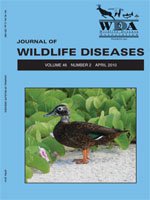Japanese encephalitis virus (JEV) and West Nile virus (WNV) are emerging zoonotic arboviruses that have recently undergone intercontinental expansion. Both JEV and WNV are naturally transmitted between mosquito vectors and vertebrate reservoir hosts, including birds. A potential route of JEV introduction from Asia to western North America is via the Hawaiian archipelago, while the spread of WNV from mainland North America to Hawai‘i is also considered an impending threat. We surveyed resident, non-native bird sera for antibodies to JEV and WNV on two Hawaiian Islands from 2004–2005. Three of 1,835 birds (0.16%) had evidence of antiflavivirus antibodies, demonstrating neutralizing activity to JEV and St. Louis encephalitis virus (SLEV). These detections could represent a limited transmission focus of either, or both, JEV and SLEV, or cross-reactive antibodies due to primary infection with an alternate flavivirus. Frequent air traffic from both Asia and North America to Hawai‘i, along with the presence of probable competent vectors and amplifying vertebrate hosts in Hawai‘i, increases the likelihood of introduction and maintenance of novel flaviviruses. Therefore, it is important to monitor for the presence of these viruses.
How to translate text using browser tools
1 April 2010
Serosurveillance for Japanese Encephalitis and West Nile Viruses in Resident Birds in Hawai‘i
Nicole M. Nemeth,
Angela M. Bosco-Lauth,
Rebecca H. Sciulli,
Remedios B. Gose,
Mark T. Nagata,
Richard A. Bowen
ACCESS THE FULL ARTICLE

Journal of Wildlife Diseases
Vol. 46 • No. 2
April 2010
Vol. 46 • No. 2
April 2010
Bird
Hawai‘i
Japanese encephalitis virus
seroprevalence
St. Louis encephalitis virus
West Nile virus




